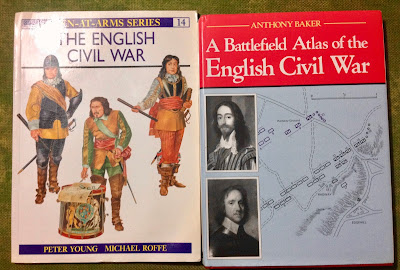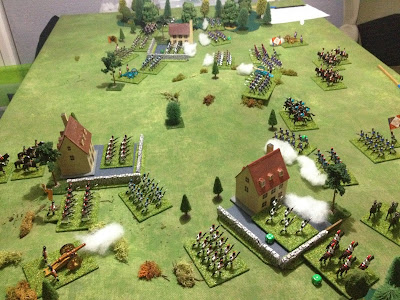My plans for this weekend's wargaming is to get around to play the next game in the French Indian War campaign. Jonathan posted the campaign moves leading up to this game earlier in the week (see
Palouse Wargaming Journal) but I have been busy playing some Napoleonic games during the week and shrinking my rules (see later).
Fort Oswego has been fought over a couple of times already in this campaign. However, there is a slight twist this time. Jonathan has noted that the French start out as a split force are arriving from the West and the South. This has been translated to their units arriving on opposite ends of the tabletop.
 |
| Notes and sketch for the next campaign game |
The British forces commanded by Amherst cannot be positioned within 4 squares of either flank, where the French are expected to arrive. On my 6x4 foot gridded tabletop this translates to 24 inches. Amherst also benefits by having one artillery piece which must be located in the fort and can have two prepared positions of earthworks.
The French, commanded by Contrecoeur, must split their force evenly. They also benefit from having one artillery piece. Looking at the orders or battle I expect to represent each regiment with two units on the tabletop.
During the week I finally go to write up my D3 napoleonic rules based on One Hour Wargaming Horse and Musket rules with a few modifications particularly on how cover is dealt with and the more oblivious use of D3 dice (1,1,2,2,3,3) where combat results are either below average, average or above average. As my current interest I shrink the rules into a booklet (ezine) form, which is fun but also means transferring them from a document to a presentation format.
 |
| The booklet (3x4 inches) - There is already a crossing out which reflects my poor proof-reading abilities. |
 |
| The booklet has 8 pages which fit onto one side of a sheet of A4 paper. |
These rules do not presently use a grid, something I may change later on. If you are interested in the changes here are the rules as they currently stand. The modifications are mainly around:
- Units disengaging from combat
- Cover is treated through hits and elimination
- Veteran units
- Use of commanders
- Army resolve
D3 Napoleonic Wargaming Rules
These rules are a variant of One-Hour Wargame Horse & Musket rules by Neil Thomas. They use a D3 dice (1,1,2,2,3,3) instead of a D6 dice (1,2,3,4,5,6).
They are geared towards games with 12 to 24 units per side.
Units
All units are singly based and represent the following unit types:
- Infantry (Line Infantry)
- Veteran Infantry (eg, Guard or Grenadiers)
- Skirmishers (Light Infantry)
- Cavalry
- Artillery
- Commander (only one per army)
Sequence of play
Players take alternating turns to move or shoot their units. A turn has the following phases:
- Movement
- Shooting
- Charges
- Elimination and Army Resolve
Movement
Unit movement allowances are:
- Cavalry - 12”
- Skirmishers and Commanders - 9”
- Infantry and Artillery - 6”
Unit may move up to their movement allowance, but never exceed it.
All movement must be in a straight-line.
Units may pivot on the centre at the start & end of their movement.
Movement must cease once a unit comes within 6” of an enemy unit. Unless the units is moving directly towards an enemy with the intent to charge them.
Infantry & artillery units engaged in combat or within 6” of an enemy unit cannot move, but may pivot to face an enemy. This counts as a move.
Cavalry & skirmish units are allowed to disengage from enemy units.
Interpenetration
Skirmishers & artillery may move through other units.
Disengaging
Once a unit is within 6” of an enemy unit they are considered to be engaged in combat & cannot disengage until the enemy is removed.
Cavalry & skirmishers are the only units which can disengage providing they move away & do not move within 6” of another enemy unit.
Terrain Effects
- Woods - Provide cover & only Skirmisher units can enter
- Towns - Provide cover & only Infantry & skirmishers may end their move in a town. Only one unit may occupy a town.
- Marsh/Lakes - impassable to all units.
- Rivers - impassable except at bridge/ford.
- Hills - Artillery line of sight is not blocked by units.
- Entrenchments - Provide cover for infantry, skirmishers & artillery units. When shooting units roll 2D3 picking the highest score.
Shooting
Only units that did not move can shoot.
Units have a 45 degree field of fire, unless they are in a town when they have a 360 degree field of fire.
Units must have a clear line of sight.
Muskets have a range of 6” & artillery 24”.
Roll the dice to determine the number of hits:
- Infantry units roll D3
- Veteran units roll D3+1
- Skirmishers roll D3-1
- Artillery units roll D3-1
Any target cavalry or skirmish unit can retire their full move to reduce the number of hits they take by 1.
As soon as a unit shoots place a marker (eg cotton wool) to show it has been engaged in combat. The unit may not move unless it can disengage or the enemy are eliminated.
Note - See elimination section for how cover is dealt with.
Charges
Only cavalry can engage other units by charging. This occurs whenever cavalry moves into contact with another unit.
Cavalry cannot engage units in cover.
The attacking cavalry unit rolls D3+1 for the number of hits which are modified by the following:
- If a target occupies a hill -1 from number of hits.
- If a target is cavalry -1 from number of hits.
- If a target unit is attacked on its flank or rear, double the number of hits.
- If the target is a skirmish unit, double the number of hits.
Artillery units are eliminated if charged & are not within 3” of any infantry unit. If within 3” then they are treated as unmanned until the cavalry move away.
Eliminating Units
A hit represents a combination of casualties, exhaustion & disorder caused to a unit by combat. Units are eliminated when they exceed 6 hits.
Units in cover can take 12 hits before being eliminated. However, once a unit in cover has taken 6 hits they are not allowed to move.
Veterans
Both armies can have up to 2-4 veteran infantry units. A veteran infantry unit rolls D3+1 when shooting.
The loss of a veteran unit deducts 2 from the army resolve.
Squares
Units can form into a square during their move. When in a square they cannot shoot & cavalry cannot attack them.
Army Resolve
An army's resolve is equal to half the number of units & plus 1 for the General, rounding up any fractions.
Each unit is eliminated reduces the resolve by 1, or 2 if a veteran unit.
Once an army’s resolve is zero, the game ends & the army retires from the field of battle.
Army Commander
All armies have a commander.
Commanders which do not move during a turn can issue move orders to all units within 6”. These units are allowed to move an additional 6”.
Commanders cannot be engaged in combat. If an approaching enemy unit comes within 6” they must move away during their turn.



















































